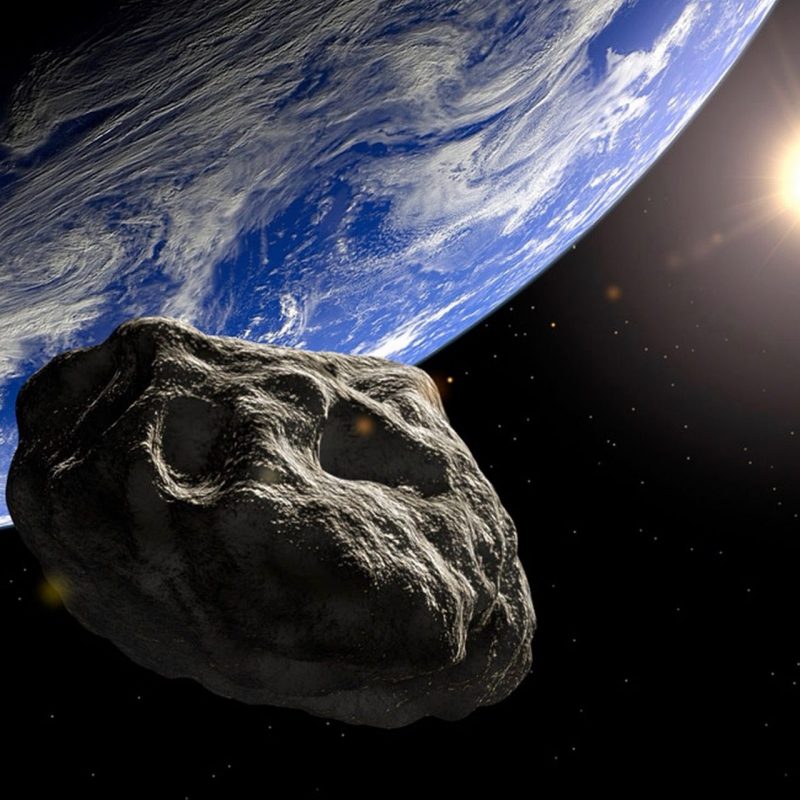
I happened to catch this post on Twitter this morning, from Tony Dunn (@tony873004), an amateur astronomer and physics teacher who knows how to create simulations of asteroids’ orbits. Tony tweeted:
Newly-discovered #asteroid C0PPEV1 paid a heavy price for almost striking Earth this morning.
Earth's gravity bent its trajectory, sending its aphelion out to the asteroid belt.https://t.co/q4qKuaUHjb pic.twitter.com/vzx5zpxGBG— Tony Dunn (@tony873004) October 31, 2019
He’s talking about near-Earth asteroid C0PPEV1, spotted in the early morning hours of October 31, 2019 by the Catalina Sky Survey in Arizona, and by other observatories soon afterwards. This small asteroid came incredibly close yesterday. According to simulations, it passed above southern Africa within 3,852 miles (6,200 km) at the moment of closest approach, around 13:45 UTC (9:45 a.m. EDT; translate UTC to your time) on October 31. That’s well within the orbit of many telecommunications satellites (geosynchronous orbits above Earth, those causing satellites to remain over a single spot on Earth’s surface, are 22,236 miles – or 35,786 km – high). It was so close that CNET reported:
According to data from these early observations, the asteroid came closer to the surface of our planet (without actually colliding with our atmosphere) than any other close approach in NASA’s database of known near-Earth objects.
EarthSky has not confirmed that C0PPEV1 came closer to Earth than any other known near-Earth object.
But we can confirm that small asteroids like C0PPEV1 do sometimes come close and, in fact, frequently enter Earth’s atmosphere. For example, the Nuclear Test Ban Treaty Organization, which operates a network of sensors that monitors Earth around the clock listening for the infrasound signature of nuclear detonations, said in 2014 that it had recorded 26 atom-bomb-scale asteroid impacts to Earth’s atmosphere since 2000.
We can also confirm that a small asteroid coming close to Earth is indeed likely to have its orbit affected. Such an effect is called a gravity assist, and it’s used by NASA and other space agencies to help propel our spacecraft toward hard-to-reach places in the solar system.
Read more: Spooky Halloween asteroid flyby one of the closest near misses ever seen
Read more: Whoa! 26 atom-bomb-scale asteroid impacts since 2000
Bottom line: Earth’s gravity bent the trajectory of small asteroid C0PPEV1 – which passed exceedingly close to Earth on October 31, 2019 – causing its aphelion, or farthest point ib orbit around the sun, to shift out in the asteroid belt between Jupiter and Mars. So long, C0PPEV1!
from EarthSky https://ift.tt/339EuOS

I happened to catch this post on Twitter this morning, from Tony Dunn (@tony873004), an amateur astronomer and physics teacher who knows how to create simulations of asteroids’ orbits. Tony tweeted:
Newly-discovered #asteroid C0PPEV1 paid a heavy price for almost striking Earth this morning.
Earth's gravity bent its trajectory, sending its aphelion out to the asteroid belt.https://t.co/q4qKuaUHjb pic.twitter.com/vzx5zpxGBG— Tony Dunn (@tony873004) October 31, 2019
He’s talking about near-Earth asteroid C0PPEV1, spotted in the early morning hours of October 31, 2019 by the Catalina Sky Survey in Arizona, and by other observatories soon afterwards. This small asteroid came incredibly close yesterday. According to simulations, it passed above southern Africa within 3,852 miles (6,200 km) at the moment of closest approach, around 13:45 UTC (9:45 a.m. EDT; translate UTC to your time) on October 31. That’s well within the orbit of many telecommunications satellites (geosynchronous orbits above Earth, those causing satellites to remain over a single spot on Earth’s surface, are 22,236 miles – or 35,786 km – high). It was so close that CNET reported:
According to data from these early observations, the asteroid came closer to the surface of our planet (without actually colliding with our atmosphere) than any other close approach in NASA’s database of known near-Earth objects.
EarthSky has not confirmed that C0PPEV1 came closer to Earth than any other known near-Earth object.
But we can confirm that small asteroids like C0PPEV1 do sometimes come close and, in fact, frequently enter Earth’s atmosphere. For example, the Nuclear Test Ban Treaty Organization, which operates a network of sensors that monitors Earth around the clock listening for the infrasound signature of nuclear detonations, said in 2014 that it had recorded 26 atom-bomb-scale asteroid impacts to Earth’s atmosphere since 2000.
We can also confirm that a small asteroid coming close to Earth is indeed likely to have its orbit affected. Such an effect is called a gravity assist, and it’s used by NASA and other space agencies to help propel our spacecraft toward hard-to-reach places in the solar system.
Read more: Spooky Halloween asteroid flyby one of the closest near misses ever seen
Read more: Whoa! 26 atom-bomb-scale asteroid impacts since 2000
Bottom line: Earth’s gravity bent the trajectory of small asteroid C0PPEV1 – which passed exceedingly close to Earth on October 31, 2019 – causing its aphelion, or farthest point ib orbit around the sun, to shift out in the asteroid belt between Jupiter and Mars. So long, C0PPEV1!
from EarthSky https://ift.tt/339EuOS

Aucun commentaire:
Enregistrer un commentaire